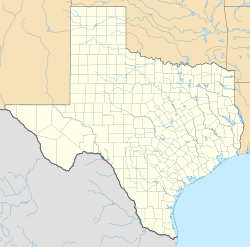Texana, Texas facts for kids
Quick facts for kids
Texana, Texas
|
|
|---|---|
| Country | United States |
| State | Texas |
| County | Jackson County |
| Santa Anna | 1832 |
| Founded by |
|
| Time zone | UTC−06:00 (CST) |
| • Summer (DST) | UTC−05:00 (CDT) |
Texana is a fascinating ghost town in Jackson County, Texas. It was once a busy place, one of the first settlements built by Anglo-Americans in the state. Texana was thriving until about 1880. But when the railroad decided to go around the town instead of through it, Texana quickly faded away. Today, the area where Texana once stood is covered by the waters of Lake Texana.
Contents
The Story of Texana
How Texana Began
In 1832, a community was started in south central Jackson County. It was founded by Dr. Francis F. Wells and his sister-in-law, Pamelia McNutt Porter. They first named the village Santa Anna. This was after Antonio López de Santa Anna, who was a popular Mexican leader at the time.
A New Name for a New Era
By 1835, Santa Anna had become an enemy of the idea of a government where people had a say. Because of this, the residents of the settlement changed its name to Texana. This new name showed their support for Texas.
Texana During the Texas Revolution
During the Texas Revolution (1835-1836), Texana was a very important place. It served as a port where people could enter Texas. It was also a training camp for many volunteers from the United States. These volunteers came to help Texas fight for its independence.
For example, Dr. Jack Shackelford's group, known as the Alabama Red Rovers, stayed near Texana for about two weeks. They then joined James Fannin's army at Goliad. In the spring of 1836, the people of Texana had to leave their homes. This event was called the Runaway Scrape. Everyone in Jackson County left, not knowing where they were going, to escape the fighting.
Texana as a County Seat
After the Battle of San Jacinto, Texas became a republic. Officials then organized the surrounding area into Jackson County. Texana, being one of the oldest Anglo-American settlements, became the county seat. This meant it was the main town for the county's government.
In the summer of 1836, the Army of the Republic of Texas set up Camp Independence. This camp was on land owned by Captain Sylvanus Hatch, a few miles from Texana. The next year, Camp Independence was the site of a famous duel between Felix Huston and Albert Sidney Johnston.
Growth and Decline
Also in 1837, there was a public sale of town lots, which encouraged more people to move to Texana. By 1840, Texana officially became a municipality, or a self-governing town.
By 1880, Texana was really booming! It had regular steamboat service, mail routes, and stagecoach routes. It had a busy business area and its own newspaper called the Clarion. As late as 1882, Texana was a thriving port. As many as twenty ships would dock there each week.
However, things changed quickly in 1883. The New York, Texas and Mexican Railway built its tracks, but it bypassed Texana. This meant the railroad went around the town instead of through it. This caused a sharp decline in Texana's importance. Soon after, the county voters chose Edna to be the new county seat. By 1884, Texana had become a ghost town.
Lake Texana
Today, the area where the ghost town of Texana once stood is covered by Lake Texana. This lake is a reservoir on the Navidad River. It was created when the Palmetto Bend Dam was finished in 1979. Lake Texana is now a popular spot for visitors to enjoy recreation. The Lavaca-Navidad River Authority manages both the dam and the lake.
Remembering Texana
In 1936, Texana, Texas, received a special marker from the Texas Historical Commission. This marker is a gray granite stone with a bronze inscription. It remembers the settlement that was founded in 1832 in Mexican Texas. You can find this historical marker at the entrance to the Lavaca-Navidad River Authority.



